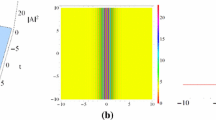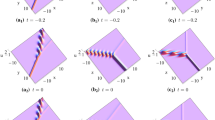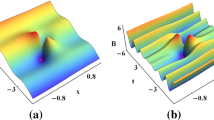Abstract
In this manuscript, we consider a coupled AB system, which describes the baroclinic instability processes in the geophysical flows. Darboux-dressing transformation is used to derive the bright-dark soliton, breather and semirational rogue wave solutions for such a system. We observe that type of the solutions is relate to the spectral parameter \(\lambda \), amplitude \(a_{1}\) and wave number q. Elastic collision between dark or bright solitons, propagations of the bright or dark breathers and rogue waves coexist with two dark or bright solitons are respectively illustrated in figures. The results about those localized wave phenomena are expected to have potential applications.
Similar content being viewed by others
Explore related subjects
Discover the latest articles, news and stories from top researchers in related subjects.Avoid common mistakes on your manuscript.
1 Introduction
It has attracted widespread attentions for the localized waves [1], including solitons [2], breathers [3] and rogue waves [4], in mathematical physics [1, 5]. Through the optical fiber experiments, breathers and solitons have been studied [6, 7]. Bright-dark solitons with the orthogonal polarization can be applied in a passively mode-locked fiber laser with a large-angle tilted fiber grating [8]. Rogue waves, regarded as the nonlinear waves localized in both space and time, have caused many attentions recently, since they may cause considerable number of maritime disasters [9]. It is hard to predict such rare events, since they appear from nowhere suddenly, that’s why their fundamental origins are still remain uncertainty [10]. Recent researches show that many factors may lead to the appearance of the rogue waves, including soliton collisions or modulation instabilities [11]. Apart from the oceans, these waves are also reported in the optics, plasmas, Bose-Einstein condensates and other fields [12,13,14,15,16].
Peregrine soliton, which is the mathematical description of a rogue wave, is a solution of the scalar nonlinear Schrödinger equation (NLSE) [17]. In addition, there exist other solutions for the NLSE, such as solitons, Akhmediev breathers (AB) and Kuznetsov-Ma (KM) solitons [18,19,20]. Compared with the scalar NLSE, coupled equations may describe extreme waves with higher accuracy, since it should be consider several amplitudes rather than a single one in a variety of physical contexts [21].
In this manuscript, we pay our attention to a coupled AB system [22,23,24,25],
which models the baroclinic instability processes in the geophysical flows, where \(A_{1}\) and \(A_{2}\) are the parameters denoting the packets of short waves and B represents the mean flow, while \(\delta \) relates to the shear and \(\sigma \) is the coefficient of the nonlinear term. System (1) has been studied in many aspects: Modulation instability has been discussed and rogue waves have been obtained by the Hirota bilinear method [22]; Properties of the dark one and two soliton solutions for System (1) have been discussed [23]; Via the Darboux transformation(DT), rogue-wave solutions have been studied [24]; With the binary DT, multi-dark soliton solutions in terms of simple determinants have been analyzed [25].
However, there is still some work to be added for System (1) besides the reports in Refs. [22,23,24,25]. Do the dark-bright solitons exist in System (1)? Do the rogue wave and bright(dark) solitons exist in System (1) simultaneously? Motivated by the above two factors, we will study the collisions between the dark-bright two solitons and semi-rational rogue waves for System (1) with the Darboux-dressing transformation(DDT) [26, 27] constructed. In Sect. 2, the first-iterated DDT will be given, and the dark-bright soliton, breather and semirational rogue-wave solutions will be constructed, while the properties of them will be analyzed and discussed in Sect. 3. Our summary will be presented in Sect. 4.
2 DDT and solutions for System (1)
2.1 Lax pair and DDT for System (1)
System (1) is an integrable model and as such admits a Lax pair [24]:
with
and \(J=\mathrm{diag}(-1,-1,1,1)\) is constant and diagonal, where U and V are \(4\times 4\) square matrices, \(\Psi \), which depends on the variables x and t, is a common solution of the two linear ordinary differential matrix equations (2), and \(\lambda \) is a complex spectral parameter, while i and \(*\) represent the imaginary unit and complex conjugate, respectively. It can be verified that System (1) is equivalent to the compatibility condition \(U_{t}-V_{x}+UV-VU = 0\).
Supposing \(\Psi _{0}\) is a corresponding fundamental solution of Lax Pair (2) with the seed solutions \(A_{1}^{[0]}\), \(A_{2}^{[0]}\) and \(B^{[0]}\), and considering the transformation
then the first-iterated Darboux-dressing transformation formulas for System (1) are
with the \(4\times 4\) square matric
and the vector
is a solution of Lax Pair (2) with \(\lambda =\chi ^{*}\), where the complex parameter \(\chi \) is a given value of the spectral parameter \(\lambda \), \(\dagger \) denotes the conjugate transpose, I is the \(4\times 4\) identity matrix and \(Z_{0}=(\Gamma _{1},\Gamma _{2},\Gamma _{3},\Gamma _{4})\) is an arbitrary complex vector, with \(\Gamma _{j}(j=1,2,3,4)\) being complex constants.
2.2 Solutions for system (1)
To obtian the dark-bright soliton and semirational rogue wave, we shoose the seed solutions as \(A_{1}^{[0]}=a_{1}e^{i*(qx+\frac{b-\delta }{q}t)}\), \(A_{2}^{[0]}=0\) and \(B^{[0]}=b\), where \(a_{1}\) and q are arbitrary real constants, which implies that \(A_{1}\) is in the nonzero background and \(A_{2}\) is in the zero background.
Next, to derive the solutions for Lax Pair (2) with the seed solutions above, we introduce a new vector eigenfunction
then the Lax Pair (2) can be written as
with
Then we can obtain the solution of the Lax Pair (2) as
By analyzing the Expression (8), we find that solutions for System (1) can be divided into two cases: (1) if \(\widetilde{U}\) and \(\widetilde{V}\) can be reduced to the diagonal forms, then \(A_{1}\) and \(A_{2}\) are exponential forms; (2) if \(\widetilde{U}\) and \(\widetilde{V}\) are similar to the Jordan forms, the semirational solutions will be derived.
By solving the characteristic polynomial
we derive the roots \(m_{1}=\frac{1}{2}[-q-\sqrt{4a_{1}^{2}+(-2\lambda +q)^{2}}]\), \(m_{2}=\frac{1}{2}[-q+\sqrt{4a_{1}^{2}+(-2\lambda +q)^{2}}]\), \(m_{3}=\frac{1}{2}[q-\sqrt{4a_{1}^{2}+(2\lambda +q)^{2}}]\) and \(m_{4}=\frac{1}{2}[q+\sqrt{4a_{1}^{2}+(2\lambda +q)^{2}}]\).
We will thus discuss the solutions for System (1) in two cases:
Case(1): dark-bright soliton solutions
\(4a_{1}^{2}+(-2\lambda +q)^{2}\ne 0\) and \(4a_{1}^{2}+(2\lambda +q)^{2}\ne 0\), which means \(m_{1}\), \(m_{2}\), \(m_{3}\) and \(m_{4}\) are not equal to each other, then \(\widetilde{U}\) can be reduced to a diagonal form
with a transformation matrix
With the transformation matrix above, \(\widetilde{V}\) can also be reduced to a diagonal form:
Then with the Expression (5) and (8), the dark-bright soliton solutions for System (1) are derived.
Case(2): semirational solutions
\(4a_{1}^{2}+(-2\lambda +q)^{2}= 0\), i.e., \(\lambda =a_{1}i+\frac{q}{2}\), \(m_{1}=m_{2}=-\frac{q}{2}\), \(m_{3}=\frac{q}{2}-\sqrt{(2ia_{1}+q)q}\) and \(m_{4}=\frac{q}{2}+\sqrt{(2ia_{1}+q)q}\), then \(\widetilde{U}\) is similar to a Jordan matrix
while \(\widetilde{V}\) is similar to a Jordan matrix
with the transformation matrix
Then with the Expression (5) and (8), the semirational solutions for System (1) are derived.
3 Discussions on the solutions
Based on solutions derived in Case(1), we will illustrate the dark-bright solitons and dark-bright breathers in Figs. 1 and 2. With the results in Case(2), the semirational rogue waves will be shown in Fig. 3.
Panels a and b show corresponding trajectories of Fig. 1a and b at \(t=-5\) (dashed line) and \(t=5\) (solid line), respectively
We observe two dark solitons in Fig. 1a and the collision between them is elastic in Fig. 2a, while in Figs. 1b and 2b, two bright solitons collide with fixed amplitudes and velocities before and after collision.
a Propagation of the bright breather; b Propagation of the dark breather. Parameters are the same as Fig. 1 except \(\lambda =1.5i\)
When we alter the value of \(\lambda \), and choose it as a pure imaginary value, the dark and bright breathers are respectively find in Fig. 3a and b. Compared with Fig. 1, structures of the solutions are related to spectral parameter \(\lambda \).
Figure 4a shows the rogue wave coexists with the two dark solitons, and elastic collision between the two solitons is shown in Fig. 5a. Also, near the collision area, we observe the breather-like structure. In Fig. 4b, rogue wave coexists with the two bright solitons are illustrated. Apart from that dark breather-like structure appears near the collision area, we find that the two solitons have different amplitudes in Fig. 5.
4 Conclusions
In summary, we have studied the a coupled AB system, i.e., System (1), which describes the baroclinic instability processes in the geophysical flows, with the Darboux-dressing transformation. The Bright-dark soliton, breather and semirational rogue wave solutions are derived by aid of the first-iterated Darboux-dressing transformation formula.
-
(1)
When the parameter \(\lambda \) is independent on amplitude \(a_{1}\) and wave number q, and \(\lambda \) is chosen as a complex parameter whose real part is a nonzero constant, elastic collisions between the dark or bright solitons have been shown in Fig. 1. In addition, when \(\lambda \) is chosen as a pure imaginary parameter, propagations of the bright or dark breathers have been observed in Fig. 2.
-
(2)
When the parameter \(\lambda \) depends on the parameters \(a_{1}\) and q, semirational rogue wave solutions are derived and rogue wave coexists with dark or bright solitons have been respectively illustrated in Fig. 3. Furthermore, the breather-like structures near the collision area have been both observed in Fig. 3a and b.
Panels a and b show corresponding trajectories of Fig. 4a and b at \(t=-15\) (dashed line) and \(t=15\) (solid line), respectively
It has been confirmed that localized wave phenomena exist experimentally [28,29,30], then we expect our results in this manuscript may be useful for the further study of solitons, breathers and rogue waves.
References
Wang, M., Chen, Y.: Dynamic behaviors of mixed localized solutions for the three-component coupled Fokas-Lenells system. Nonlinear Dynam. 98, 1781 (2019)
Meng, G.Q.: High-order semi-rational solutions for the coherently coupled nonlinear Schrödinger equations with the positive coherent coupling. Appl. Math. Lett. 105, 106343 (2020)
Wang, L., Liu, C., Wu, X., Wang, X., Sun, W.R.: Dynamics of superregular breathers in the quintic nonlinear Schrödinger equation. Nonlinear Dynam. 94, 977 (2018)
Xie, X.Y., Yang, S.K., Ai, C.H., Kong, L.C.: Integrable turbulence for a coupled nonlinear Schrödinger system. Phys. Lett. A 384, 126119 (2020)
Kong, L.Q., Wang, L., Wang, D.S., Dai, C.Q., Wen, X.Y., Xu, L.: Evolution of initial discontinuity for the defocusing complex modified KdV equation. Nonlinear Dynam. 98, 691 (2019)
Hasegawa, A., Tappert, F.: Transmission of stationary nonlinear optical pulses in dispersive dielectric fibers. II. Normal Dispersion. Appl. Phys. Lett. 23, 171 (1973)
Mollenauer, L.F., Stolen, R.H., Gordon, J.P.: Experimental observation of picosecond pulse narrowing and solitons in optical fibers. Phys. Rev. Lett. 45, 1095 (1980)
Zhang, G., Yan, Z.: The n-component nonlinear Schrödinger equations: dark-bright mixed N-and high-order solitons and breathers, and dynamics. P. Roy. Soc. A-Math. Phys. 474, 20170688 (2018)
Kivshar, Y.S., Flach, S.: Focus issue-Nonlinear localized modes: Physics and applications. Chaos 13, 586 (2003)
Baronio, F., Degasperis, A., Conforti, M., Wabnitz, S.: Solutions of the vector nonlinear Schrödinger equations: evidence for deterministic rogue waves. Phys. Rev. Lett. 109, 044102 (2012)
Soto-Crespo, J.M., Devine, N., Akhmediev, N.: Integrable turbulence and rogue waves: breathers or solitons? Phys. Rev. Lett. 116, 103901 (2016)
Chabchoub, A., Hoffmann, N., Onorato, M., Akhmediev, N.: Super rogue waves: observation of a higher-order breather in water waves. Phys. Rev. X 2, 011015 (2012)
Solli, D.R., Ropers, C., Koonath, P., Jalali, B.: Optical rogue waves. Nature 450, 1054 (2007)
Moslem, W.M., Shukla, P.K., Eliasson, B.: Surface plasma rogue waves. EPL 96, 25002 (2011)
Bludov, Y.V., Konotop, V.V., Akhmediev, N.: Matter rogue waves. Phys. Rev. A 80, 033610 (2009)
Shats, M., Punzmann, H., Xia, H.: Capillary rogue waves. Phys. Rev. Lett. 104, 104503 (2010)
Peregrine, D.H.: Water waves, nonlinear Schrödinger equations and their solutions. J. Aust. Math. Soc. Ser. B 25, 16 (1983)
Ankiewicz, A., Soto-Crespo, J.M., Akhmediev, N.: Rogue waves and rational solutions of the Hirota equation. Phys. Rev. E 81, 046602 (2010)
Guan, X., Liu, W., Zhou, Q., Biswas, A.: Darboux transformation and analytic solutions for a generalized super-NLS-mKdV equation. Nonlinear Dynam. 98, 1491 (2019)
Liu, S., Zhou, Q., Biswas, A., Liu, W.: Phase-shift controlling of three solitons in dispersion-decreasing fibers. Nonlinear Dynam. 98, 395 (2019)
Baronio, F., Degasperis, A., Conforti, M., Wabnitz, S.: Solutions of the vector nonlinear Schrödinger equations: evidence for deterministic rogue waves. Phys. Rev. Lett. 109, 044102 (2012)
Wu, C.F., Grimshaw, R.H.J., Chow, K.W., Chan, H.N.: A coupled AB system: Rogue waves and modulation instabilities. Chaos 25, 103113 (2015)
Xie, X.Y., Meng, G.Q.: Dark-soliton collisions for a coupled AB system in the geophysical fluids or nonlinear optics. Mod. Phys. Lett. B 32, 1850039 (2018)
Su, J.J., Gao, Y.T., Ding, C.C.: Darboux transformations and rogue wave solutions of a generalized AB system for the geophysical flows. Appl. Math. Lett. 88, 201 (2019)
Xie, X.Y., Meng, G.Q.: Multi-dark soliton solutions for a coupled AB system in the geophysical flows. Appl. Math. Lett. 92, 201 (2019)
Matveev, V.B., Salle, M.A.: Darboux Transformations and Solitons. Springer, Berlin (1991)
Degasperis, A., Lombardo, S.: Multicomponent integrable wave equations: II soliton solutions. J. Phys. A 42, 385206 (2009)
Stegeman, G.I., Segev, M.: Optical spatial solitons and their interactions: universality and diversity. Science 286, 1518 (1999)
Xie, X.Y., Liu, X.B.: Elastic and inelastic collisions of the semirational solutions for the coupled Hirota equations in a birefringent fiber. Appl. Math. Lett. 105, 106291 (2020)
Frisquet, B., Kibler, B., Morin, P., Baronio, F., Conforti, M., Millot, G., Wabnitz, S.: Optical dark rogue wave. Sci. Rep. 6, 20785 (2016)
Acknowledgements
This work has been supported by the National Natural Science Foundation of China under Grant Nos. 11905061 and by the Fundamental Research Funds for the Central Universities (No. 2018MS132).
Author information
Authors and Affiliations
Corresponding author
Ethics declarations
Conflict of interest
The authors declare that they have no conflict of interest.
Additional information
Publisher's Note
Springer Nature remains neutral with regard to jurisdictional claims in published maps and institutional affiliations.
Rights and permissions
About this article
Cite this article
Xie, XY., Liu, ZY. & Xu, DY. Bright-dark soliton, breather and semirational rogue wave solutions for a coupled AB system. Nonlinear Dyn 101, 633–638 (2020). https://doi.org/10.1007/s11071-020-05794-1
Received:
Accepted:
Published:
Issue Date:
DOI: https://doi.org/10.1007/s11071-020-05794-1









